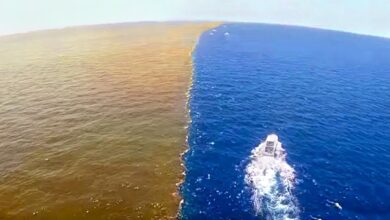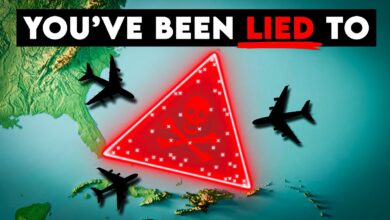YELLOWSTONE’S Final Warning: Should We Pack Our Bags?

Volcanoes, particularly supervolcanoes, can create dramatic and life-threatening eruptions, but not all volcanic activity is catastrophic. Mauna Loa, the world’s largest active volcano, has been dormant for decades, although recent seismic activity suggests it might erupt again soon. If it does, the lava could flow quickly, affecting populated areas like Captain Cook in Hawaii. Despite its size, Mauna Loa’s eruptions tend to be less violent compared to other volcanoes, as it is a shield volcano, producing fluid lava that flows far but doesn’t create massive ash clouds.
Supervolcanoes, like Yellowstone and Toba, are capable of eruptions that can drastically change global climates. Supervolcanoes form from massive magma chambers beneath the Earth’s surface, and when they erupt, they can release vast amounts of ash and gases into the atmosphere, leading to cooling periods. The last major eruption occurred around 26,500 years ago in New Zealand’s Taupo volcano, while Yellowstone, which erupted three times in the past 2 million years, remains a significant threat.
Smaller eruptions, such as Mount Tambora in 1815, have caused significant global cooling, as ash clouds blocked sunlight, leading to crop failures and a “year without summer.” Similarly, volcanic events can create lasting atmospheric effects, but they are rare, with supervolcanoes erupting roughly once every 100,000 years.
While the possibility of all volcanoes erupting at once is extremely unlikely, massive eruptions could have devastating global effects. Volcanic gases and ash could block sunlight, disrupt agriculture, and alter the Earth’s climate for years. However, scientists believe it’s improbable that all volcanoes will erupt simultaneously, as they each have independent magma sources.
Antarctica is home to active volcanoes, including Mount Erebus, which has erupted continuously since 1972, and Deception Island, which last erupted over 50 years ago. While these volcanoes are closely monitored, there are also numerous volcanic vents releasing gases and vapors, which can sometimes form icy towers up to 10 feet high. A more concerning threat is super volcanoes, such as Yellowstone, which have vast magma chambers that could cause catastrophic eruptions. Yellowstone, though capable of a colossal eruption, has had just three major eruptions in the past 2.1 million years, and current conditions do not suggest an imminent eruption.
Scientists monitor Yellowstone through extensive methods, including tracking seismic activity and ground deformation. While the threat of a major eruption remains low, such an event could have global climatic effects. The largest volcanic region on Earth is beneath Antarctica, with 138 volcanoes identified, though only two are currently active. These volcanoes, such as Mount Erebus, emit gas and steam, but it would take a series of eruptions over decades to significantly impact the planet.
If Antarctic volcanoes were to erupt, they could melt large amounts of ice, raising sea levels. However, this scenario remains unlikely. Even more rare, volcanoes beneath ice sheets could melt ice, potentially triggering a “runaway effect” like in Iceland at the end of the last ice age. While Antarctica holds most of the world’s fresh water, a major eruption would not lead to the end of the world. A more likely consequence would be a gradual rise in sea levels.
Past super eruptions, like those of Camp and Toba, have altered the planet’s climate. A super eruption at Yellowstone would have devastating consequences, but such events are rare. The last major eruption at Yellowstone occurred 640,000 years ago, and current data suggest no immediate threat. Scientists continue to monitor volcanic activity, but major eruptions remain unlikely in the near future.
The eruption of the Toba supervolcano around 74,000 years ago may have posed a serious threat to early humans, but some of our ancestors might have survived in coastal areas. Genetic evidence suggests modern humans trace their roots to a small group of people who left Africa about 60,000 years ago. The Toba eruption, which released 1,000 cubic miles of dust and rock, likely cooled the Earth’s surface, causing glaciers to form and sea levels to drop. Some experts believe that the eruption could have devastated the majority of early humans, while those along the coast may have thrived.

A 2011 discovery in South Africa’s Pinnacle Point, where volcanic ash was found, suggests early humans survived the eruption, improving their tools and living along the coastline for thousands of years. The eruption might have lowered global temperatures by 14°F, making survival difficult elsewhere in Africa. However, newer studies argue that the sulfur released by Toba could have limited the cooling effect in the long term, with temperatures dropping initially but stabilizing after a few years.
Meanwhile, volcanic activity remains a concern today. Several active volcanoes, including Italy’s Vesuvius and Washington’s Mount Rainier, pose significant risks. Mount Vesuvius, notorious for destroying Pompeii in 79 CE, continues to erupt periodically, while Mount Rainier threatens nearby suburbs with pyroclastic flows. Other active volcanoes, such as Alaska’s Novarupta and the Philippines’ Mount Pinatubo, have produced devastating eruptions in the past, and Indonesia’s Mount Merapi is also highly active.
Yellowstone National Park sits atop a massive supervolcano, which has been a source of concern due to its size and potential for eruption. Researchers discovered a magma chamber much larger than previously thought, and it could potentially erupt in an apocalyptic event. Despite increased seismic activity in the region, experts believe the volcano isn’t likely to erupt soon, as there is not enough magma or pressure to cause an eruption. However, they continue to monitor signs such as increased earthquake frequency and ground deformation.
If Yellowstone were to erupt, the consequences would be catastrophic. The eruption would send massive amounts of ash into the atmosphere, blocking the sun and cooling the planet, similar to past eruptions that caused global temperature drops and mass extinctions. The last major eruption of Yellowstone occurred 640,000 years ago, and while experts don’t expect another soon, the potential remains.
Volcanic activity also continues around the Pacific Ring of Fire, with Mount Etna in Sicily remaining one of Europe’s most active volcanoes. Though the risks of a supervolcano eruption are remote, active volcanoes still pose significant threats to millions of people worldwide.
On July 10, 2023, a new volcano erupted in Iceland, marking the birth of Europe’s youngest volcano. The eruption took place on a peninsula in the southwest of the island, where fissures opened up in the ground. This followed years of seismic activity and previous eruptions in the same volcanic area. Despite the event’s intensity, scientists were not surprised, as they had been monitoring the region for years. The volcano erupted with molten lava and gas plumes, and local authorities quickly cordoned off the area to protect citizens from toxic gases.
Iceland is a hotspot for volcano tourism, with more than 130 volcanoes, 30 of which are active. Tourists often visit to witness volcanic eruptions up close. In Iceland, volcanoes are carefully monitored by authorities, ensuring that the public can safely observe them. During a past eruption in 2010, volcanic ash disrupted air travel across Europe, highlighting the potential global impact of Iceland’s eruptions.
The eruption in 2023 created an elongated lava cone, which quickly filled a crater and grew over 100 feet tall. Scientists were able to predict the volcano’s behavior due to their extensive seismic monitoring network, which provides warnings of impending eruptions. The eruption generated a river of slow-moving lava, which is categorized as AA lava, known for its rough, brittle texture. The eruption also caused the formation of a rare lava tornado, a phenomenon observed in other volcanic eruptions around the world.
Iceland’s volcanic activity is a result of the island’s position above the tectonic plate boundary between North America and Eurasia. These tectonic movements have created the landforms that make Iceland so geologically active. The country has experienced ongoing volcanic eruptions for millions of years, with the oldest rock formations in Iceland being only 16 million years old. Iceland’s active lava fields continue to push the island outward as new lava reaches the surface and cools.
While Iceland is known for its volcanic activity, scientists are now predicting that the island may face decades of increased eruptions. This change could be linked to historical patterns where glacial retreat disrupts the flow of magma, causing more frequent eruptions. Iceland’s volcanic landscape is a reminder of the dynamic forces that shape the planet, and the recent eruption is just the beginning of a new era of volcanic activity for the island.
Supervolcanoes, much larger and more destructive than typical volcanoes, are capable of erupting vast amounts of magma and can cause catastrophic damage. While the eruption of Iceland’s new volcano is not of this scale, it serves as a stark reminder of the power of nature and the ongoing geological processes that shape our planet.








